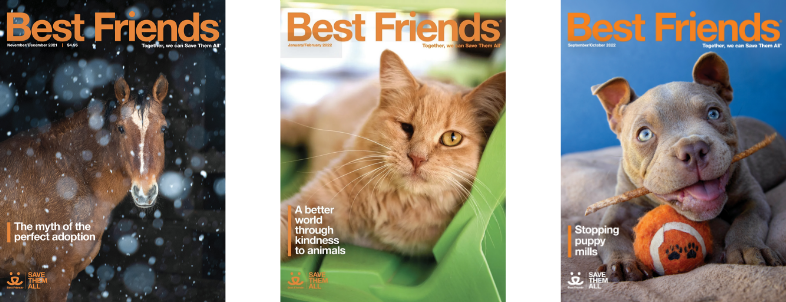Rescuing animals, one flight at a time
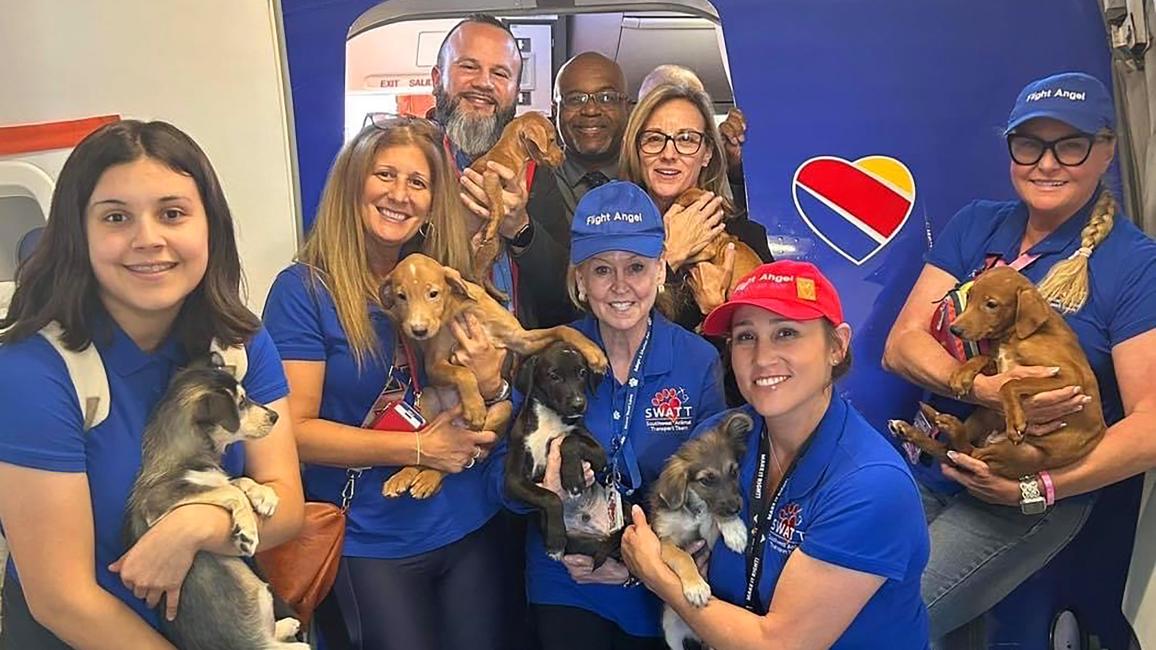
The next time you fly Southwest Airlines and see a cat or dog on board, pay extra attention. You might be witnessing a rescue in progress with a unique twist: The person handling the pet is likely a Southwest Airlines employee who has given up a day off to save this animal.
That employee is part of the Southwest Animal Transport Team (SWATT), comprising hundreds of individuals who volunteer their time to help homeless animals. “In what I call the cycle of save, we help shelters and rescue groups transport animals so they can clear space for other animals,” says Elaine Brown, SWATT’s founder and CEO. “It’s one way we’re going to help Best Friends achieve a no-kill nation.” To date, the program has completed about 2,000 rescue missions.
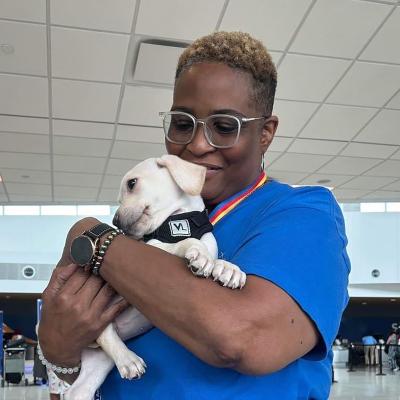
Getting SWATT off the ground
SWATT got its start in 2017 when Elaine was introduced to a similar program that Delta Airlines employees started called Delta Animal Rescue Transport (DART). “After a friend posted about her DART transport on Facebook, it was an aha moment,” she says. “I realized I could combine my nonprofit background in animal welfare, love for animals, passion for the no-kill movement, and airline career to work on behalf of animals.” Elaine collaborated with DART to create SWATT.
Today, SWATT is a 100% volunteer-driven organization whose backbone consists of Flight Angels who fly animals on their days off. “They range from flight attendants and pilots to ticket counter agents and loading crews. We have every work group represented in SWATT,” Elaine says. “Almost all of us work full time and half of us are in the sky, so this gives us an opportunity to help animals.” Flight Angels can also be dependents of employees or retirees. There are nearly 3,000 Flight Angels located around the country who use their employee benefits to fly standby across the United States, to Puerto Rico, and between the islands of Hawaii with rescued dogs and cats.
[Pilot uses ‘compassion flights’ to save the lives of homeless cats and kittens]
To qualify, animals have to meet specific requirements of the airline as well as SWATT. For starters, an animal can weigh no more than 18 pounds to fit into an airline-approved carrier that will be placed under a seat in the cabin of the plane. Two pets of the same species, though, can be in the same carrier, as long as their combined weight isn’t over 20 pounds, which has proven beneficial. “It’s one reason we can save so many animals,” Elaine says. Each animal must also be at least 8 weeks old and fully weaned. Finally, animals have to be up to date on their vaccines based on their age, be seen by a USDA-accredited veterinarian, and fly with a health certificate to affirm that.
Where do the dogs and cats come from? Rescue groups and shelters that have applied to be SWATT partners. Not every SWATT partner, however, is a no-kill organization, so Elaine uses the opportunity to educate them. “I talk about the no-kill movement and encourage them to move in that direction,” she says.
Where the animal is flying depends on his or her situation. The pet might be going to another rescue group, shelter, or even an adopter. In one instance, SWATT transported a cat who was adopted from Best Friends and needed to return there for treatment of medical issues.
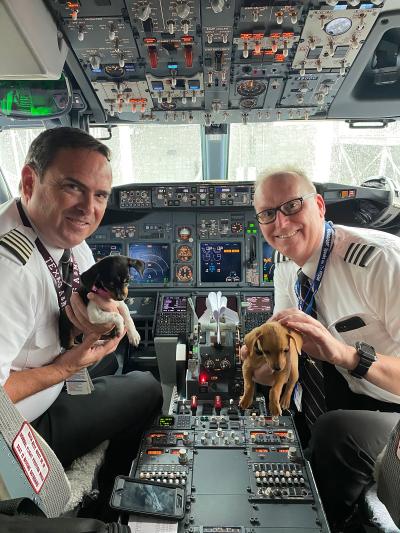
Behind the scenes
In 2023, Flight Angels helped more than 500 animals. Each transport is designed to take a day and usually involves one Flight Angel. If the flight involves two legs, however, it will often be split between two Flight Angels, so each can get home that day.
As you can imagine, the logistics of putting together these missions is complex. The process starts when a SWATT partner requests a transport. Information about the rescue group and the animal is shared to a private Facebook page, where interested Flight Angels can respond. Once a volunteer is confirmed, one of SWATT’s four transport coordinators creates a flight plan, evaluating not only the route but also the flight load. “Because we’re flying standby, there has to be an empty seat for us,” Elaine explains. Next, the rescue group or shelter approves the plan. As soon as it does, it’s wheels up.
That doesn’t mean, though, that every flight goes off as scheduled, thanks largely to Mother Nature. For instance, storms might disrupt flights and alter flight schedules. Those circumstances can then affect the standby list and change a Flight Angel’s ability to get on board, moving the transport to later in the day or the next day. “That’s why I say every transport is unique,” Elaine says.
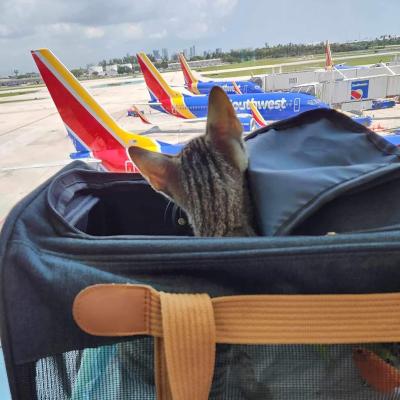
How a transport day works
Of course, anybody who has flown knows how stressful it can be. It’s undoubtedly even more so for the animals, which is why SWATT takes extra precautions to ensure a smooth rescue and alleviate as much stress as possible. Representatives of the rescue group or shelter are asked to bring the pet inside the airport to meet the Flight Angel two hours before the flight. The Flight Angel then goes to the ticket counter to let the crew know an animal will be on board and buys a ticket for the animal, which the rescue organization pays for.
When it’s time to go through security, SWATT has strict guidelines to keep the animals safe. Cats always get a private screening in a closed room. “Cats are more skittish than dogs,” Elaine explains. After the cat is taken out of the carrier, TSA personnel send the carrier through the X-ray machine and then bring the carrier back to the room. Most dogs go directly through TSA, although wiggly puppies might require a private screening. At the final destination, the Flight Angel is met inside the airport by the person receiving the animal. “It’s a way for the Flight Angel to say goodbye,” Elaine says.
[Lifesaving rides for pets in Navajo Nation]
An active transport was canceled only once because of a Chihuahua who froze going through security. “He wouldn’t come out of his carrier, even after several people tried, and we didn’t want to push him anymore,” Elaine says. Instead, the rescue group arranged for him to be driven by car.
While rescuing animals one flight at a time is SWATT’s main focus, there are other ways that Flight Angels can help pets. Through its ambassador program called PAWssadors, Flight Angels serve as paws on the ground in their community and do Acts of Kindness events for animals. They might, for instance, help with adoption events and food banks or help load animals for ground transports. In addition, Elaine will be launching the Caring for Rescued Animals to Transport in an Emergency (CRATE) Crew, a FEMA-trained disaster response team made up of Flight Angels. “Whenever there’s a disaster, the CRATE Crew could be deployed to assist Best Friends and other organizations in saving animals,” she says.
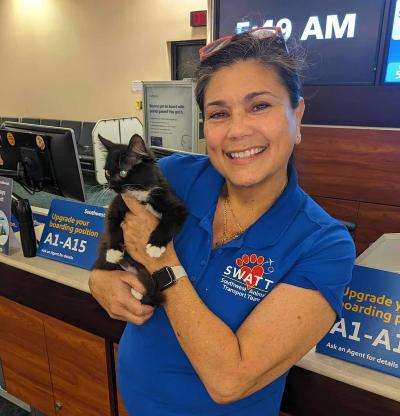
How the public can help
SWATT is so committed to helping Best Friends that four years ago, the group began holding an annual retreat at the Sanctuary in Kanab, Utah, inviting Flight Angels and rescue partners. This year will mark its fifth one. Elaine notes, “It’s not only inspiring but also moving for the volunteers to have this direct connection with Best Friends.”
Each year, Best Friends arranges a special program for the SWATT team. During the 2023 trip, they toured the facilities, spent time with Best Friends founders, had multiple kitten sleepovers, and participated in a special bricklaying ceremony at Angels Rest.
All of this leads to perhaps an obvious question: How can the public help SWATT? Elaine says, “Let your local shelters and rescue groups know about us and encourage them to apply to be a partner.” The application is available at swattransport.org. They can also follow SWATT on Facebook and Instagram at @SWATT_Transport.
More than anything, Elaine hopes that seeing Flight Angels in action will encourage the public to help homeless pets. “I hope that not only will they love what we’re doing, this will also trigger them to save an animal,” she says, perhaps by stopping to help a stray animal or adopting an animal from a shelter. In the meantime, Elaine is recruiting more Flight Angels so that SWATT can fill every request for a transport. It’s all part of the cycle of save. “Every life is worth saving,” she says.
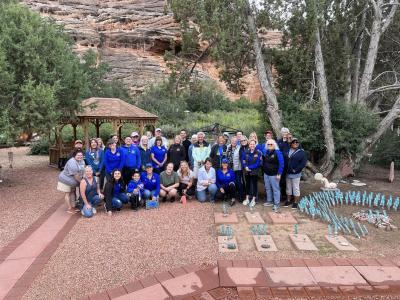
This article was originally published in the March/April 2024 issue of Best Friends magazine. Want more good news? Become a member and get stories like this six times a year.
Let's make every shelter and every community no-kill by 2025
Our goal at Best Friends is to support all animal shelters in the U.S. in reaching no-kill by 2025. No-kill means saving every dog and cat in a shelter who can be saved, accounting for community safety and good quality of life for pets.
Shelter staff can’t do it alone. Saving animals in shelters is everyone’s responsibility, and it takes support and participation from the community. No-kill is possible when we work together thoughtfully, honestly, and collaboratively.
